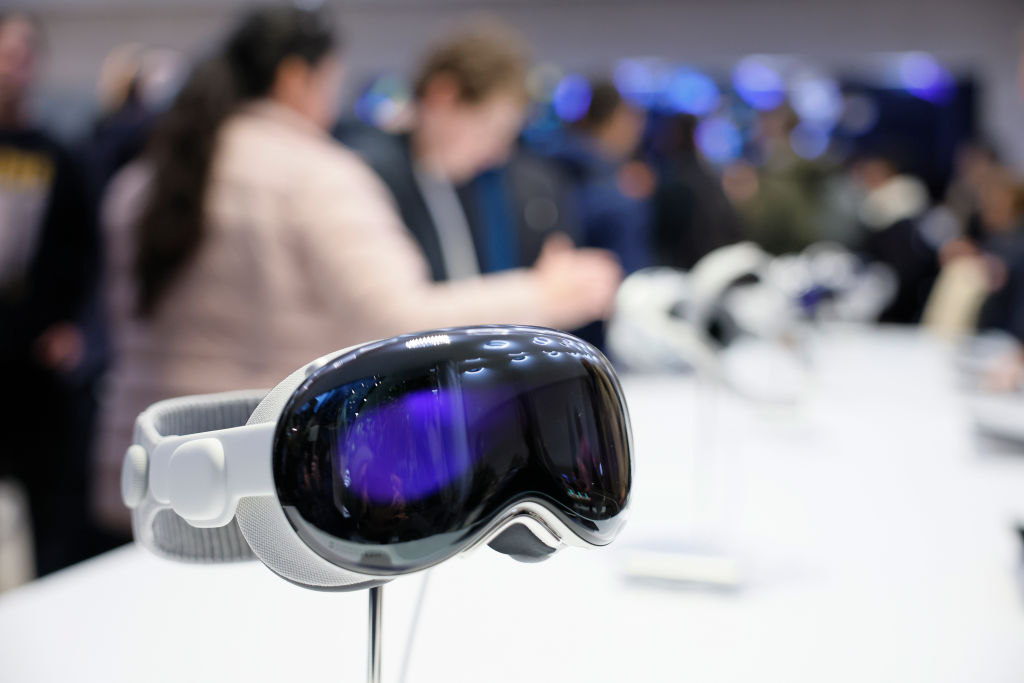After Decades of Promise, the Virtual Reality Era Has Finally Arrived
Virtual reality is a paradigm shift for consumer technology. The tech has a long road ahead, but amazing hardware already puts the huge potential on full display.


To help you understand what is going on in the tech sector our highly experienced Kiplinger Letter team will keep you abreast of the latest developments and forecasts (Get a free issue of The Kiplinger Letter or subscribe). You'll get all the latest news first by subscribing, but we will publish many (but not all) of the forecasts a few days afterward online. Here’s the latest…
The virtual reality industry got a much-needed jolt when Apple finally joined the fray with its first VR headset. If any company can bring face-worn devices to an audience beyond gamers, it’s the tech giant that introduced the world to the smartphone. “Apple is focused on the mass market,” says Jitesh Ubrani, research manager at IDC. “Apple is doing a great job introducing the technology to many people.”
It's still early days. But there’s huge long-term potential. Here’s an outlook for VR and the many ways it will be used.

Sign up for Kiplinger’s Free E-Newsletters
Profit and prosper with the best of expert advice on investing, taxes, retirement, personal finance and more - straight to your e-mail.
Profit and prosper with the best of expert advice - straight to your e-mail.
Vast improvements in tech components make amazing VR possible today. Headsets run on energy-efficient yet powerful mobile chips, and are packed with components: A memory chip, fast Wi-Fi, a slew of cameras, high-end eye displays, microphones, speakers, laser-scanning sensors, motion sensors, tiny cooling fans. (But batteries, on board or in a connected pack, are still heavy, yet last just 2-3 hours.) Users can fully immerse in a virtual world for calls, gaming, entertainment, etc. Or the front-facing cameras make a live video stream and 3D scan of the room so users can see their real environment populated by virtual screens or holograms.
Today’s models will seem clunky in 5 to 10 years, as big improvements occur to shrink the size and weight, without hindering performance. Costs will fall, too.
The leaders are Apple and Meta. Meta has about 60% of global headset sales, focusing on lower-cost models ($500 or less) for gaming and social virtual worlds. Apple’s $3,500 Vision Pro has a dazzling display and dozens of high-end components, plus a new VR operating system that takes familiar apps and puts them into VR. Plus, Apple built two new chips: One for computing and one for eye/hand tracking. The device is controlled by incredibly precise eye and hand tracking. A simple glance at a digital icon and a subtle tap of two fingers will select it, with no noticeable lag.
There are plenty of other players, too. HTC, DPVR, Valve, Varjo, HP and China’s ByteDance make high-quality headsets. Alphabet, Samsung and Huawei are among the tech giants expected to launch a device. Augmented-reality glasses, a related category, are not full VR and use transparent lenses to overlay digital info onto the real world. Top vendors include Xreal, Vuzix, Magic Leap and Microsoft.
The possibilities are nearly endless when it comes to specific VR uses. But Apple shows how VR can eventually be a general computing device. Think of Apple’s breakthrough VR operating system, visionOS, as Windows for VR, a new way to access web browsers, e-mails, documents, photos and all other apps. A crisp PC monitor, any size, can float in a fixed position in the room in front of you. Other apps, such as photos or a calendar, can open to the sides or hang on a wall. You can put these holographic monitors in the actual room or turn your workspace into any setting, such as a rocky coast in Washington, a tranquil lake in Maine or a beach in Italy. Early businesses testing Apple VR include Walmart, Vanguard, SAP and Stryker.
On-the-go workers can set up a virtual office anywhere, such as on a plane, in a crowded bus or in a hotel room. Even in a cramped taxi, users can multitask with huge displays and multiple windows open. Open a spreadsheet on one side, e-mail in the center and a web browser to the right. Receiving a call? A video chat will open in front of you, either in 2D or as a 3D avatar. Talking about a new product or design? A 3D hologram will appear on the desk and colleagues can collaborate to spin the object around, test updates and take notes on a virtual whiteboard.
VR will remain a niche market in the near term, hindered by high costs and a lack of VR content. But content is coming, as developers build VR apps, and Hollywood and others shift production to VR videos. Still, expect strong headset sales in coming years. By 2028, global yearly shipments of VR/AR headsets will hit 35 million, up from nearly 10 million this year, according to market research firm IDC. Apple’s device will sell at least 400,000 units in 2024. Expect Apple’s VR business to grow significantly, to about 10% of revenue, about the same share as iPad. Daily usage will rise steadily, too, a key metric.
There’s a rapidly growing list of uses for VR, including many practical ones. Today’s office apps are being optimized for VR. From collaboration tools such as Microsoft Teams and Slack, and web-based storage services such as Box, to project management tools such as OmniPlan, and video chats with life-size screens.
Some of the specific areas that are promising:
- Sales. You can show products, such as heating systems, medical equipment, tools and more as 3D holograms at trade shows. Present large luxury goods that are tough to stock, such as yachts, RVs and private jets in a small showroom or on the road. Try on clothes or see new furniture at home.
- Design and prototyping. Bring designers together in a virtual room to jointly see a digital version of a product, such as high-end cars. Reduce the need for physical models and in-person reviews, plus make product tweaks easier. Models can also be brought anywhere. A prototype virtual truck can be placed on a real street, for example.
- Health care. Train doctors, nurses, surgeons, physical therapists, etc. Nurses can dissect cadavers or conduct a series of patient assessments on an avatar. Medical students can learn how to place electrodes for an electrocardiogram. Dental students can examine digital mouths and extract teeth. In real-life situations, surgeons can get patient info or share live video to get a consult with a remote expert.
- Real estate. Immersive tours of homes for buyers, sellers and agents to take 3D walk-throughs and overlay digital info, such as floor plans and room size. Avoid the wasted time of an in-person visit to a property a buyer wouldn’t like, and boost the odds of prospective buyers making a trip to a promising property.
- First response. Train police, firefighters and other emergency personnel in dangerous situations, such as unruly protesters, active shooters or a fiery car crash, with VR videos that track performance, offer new scenarios and speed up training.
- Mechanical fields, such as engineering, manufacturing, construction and more. Train welders, home builders, aviation mechanics, truck drivers, electricians, etc. Assemble and disassemble complex machines. Practice maintenance and new builds.
- Plus, entertainment, including concerts, video games, TV, theater and virtual worlds. Watch live sports — a baseball game from the dugout or a basketball game courtside.
VR has the potential to cannibalize other tech segments, including PC monitors, big-screen TVs, game consoles and smartphones. Movies are stunning in VR and will give theaters competition. Still, the apps that will harness VR the best have yet to be built. But they are coming soon and will start winning over new users. Start-ups and tech giants alike will find moneymaking opportunities in VR. To get there, expect even bigger investment from companies and venture capitalists.
This forecast first appeared in The Kiplinger Letter, which has been running since 1923 and is a collection of concise weekly forecasts on business and economic trends, as well as what to expect from Washington, to help you understand what’s coming up to make the most of your investments and your money. Subscribe to The Kiplinger Letter.
Get Kiplinger Today newsletter — free
Profit and prosper with the best of Kiplinger's advice on investing, taxes, retirement, personal finance and much more. Delivered daily. Enter your email in the box and click Sign Me Up.

John Miley is a Senior Associate Editor at The Kiplinger Letter. He mainly covers technology, telecom and education, but will jump on other important business topics as needed. In his role, he provides timely forecasts about emerging technologies, business trends and government regulations. He also edits stories for the weekly publication and has written and edited e-mail newsletters.
He joined Kiplinger in August 2010 as a reporter for Kiplinger's Personal Finance magazine, where he wrote stories, fact-checked articles and researched investing data. After two years at the magazine, he moved to the Letter, where he has been for the last decade. He holds a BA from Bates College and a master’s degree in magazine journalism from Northwestern University, where he specialized in business reporting. An avid runner and a former decathlete, he has written about fitness and competed in triathlons.
-
 How to Get Apple TV Plus for just $2.99
How to Get Apple TV Plus for just $2.99For a limited time, you can get three months of Apple TV Plus for just $2.99 per month. Here’s how to get the deal.
By Rachael Green Published
-
 Stock Market Today: Stocks Surge to Close a Volatile Week
Stock Market Today: Stocks Surge to Close a Volatile WeekIt was another day with a week's worth of both news and price action, but it ended on a strongly positive note.
By David Dittman Published
-
 The New Space Age Takes Off
The New Space Age Takes OffThe Kiplinger Letter From fast broadband to SOS texting, space has never been more embedded in peoples’ lives. The future is even more exciting for rockets, satellites and emerging space tech.
By John Miley Published
-
 Rising AI Demand Stokes Undersea Investments
Rising AI Demand Stokes Undersea InvestmentsThe Kiplinger Letter As demand soars for AI, there’s a need to transport huge amounts of data across oceans. Tech giants have big plans for new submarine cables, including the longest ever.
By John Miley Published
-
 What DOGE is Doing Now
What DOGE is Doing NowThe Kiplinger Letter As Musk's DOGE pursues its ambitious agenda, uncertainty and legal challenges are mounting — causing frustration for Trump.
By Matthew Housiaux Published
-
 A Move Away From Free Trade
A Move Away From Free TradeThe Letter President Trump says long-term gain will be worth short-term pain, but the pain could be significant this year.
By David Payne Published
-
 The Explosion of New AI Tools
The Explosion of New AI ToolsThe Kiplinger Letter Workers and consumers soon won’t be able to escape generative AI. Does that mean societal disruption and productivity gains are right around the corner?
By John Miley Published
-
 Trump’s Whirlwind Month of Crypto Moves
Trump’s Whirlwind Month of Crypto MovesThe Kiplinger Letter The Trump administration wants to strengthen U.S. leadership in the cryptocurrency industry by providing regulatory clarity.
By Rodrigo Sermeño Published
-
 Excitement Over AI Propels IT Spending
Excitement Over AI Propels IT SpendingThe Kiplinger Letter IT sales set to surge in 2025 as businesses rush to adopt generative AI.
By John Miley Published
-
 Donald Trump Tests His Limits
Donald Trump Tests His LimitsThe Kiplinger Letter President Encounters Legal Obstacles in Pursuit of Ambitious Agenda.
By Matthew Housiaux Published